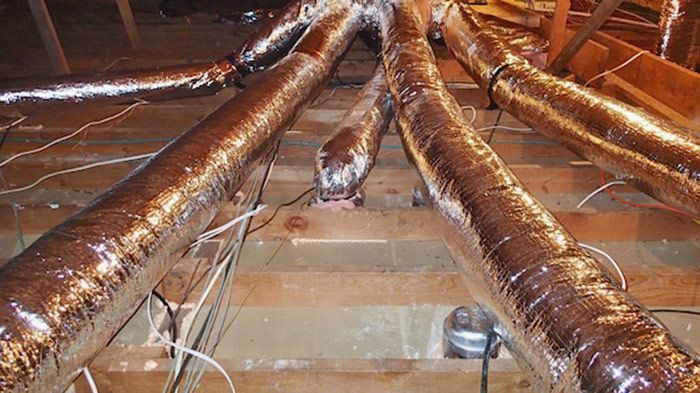Is R-8 Duct Insulation Enough?
Code requirements are always a compromise between what’s best and what’s practical.

If you know a little building science, you’ve no doubt seen a lot of problems that occur with air distribution systems. Ducts just don’t get anywhere near the attention they deserve in most homes.
I’ve written about ducts quite a bit here and have shown problems resulting from poor design and installation. We all know how stupid some of those problems are. So today I’m going to talk about a problem that doesn’t get nearly enough attention: duct insulation — even when the design and installation are perfect.
OK, maybe the design isn’t quite perfect. If it were, all the ducts would be in conditioned space. That would be the smart thing to do and would make duct insulation less important. What I’m talking about is a house with ducts in unconditioned space, especially an unconditioned attic.
Our R-value cognitive dissonance
I’m in Georgia (IECC Climate Zone 3), where our current state code requires R-13 in exterior walls, R-18 in attic kneewalls, R-19 in floors, and R-30 in ceilings. If we put ducts in unconditioned space, they have to be insulated to either R-8 (if they’re in an unconditioned attic) or R-6 (in any other type of unconditioned space).
Have you ever considered the temperature differences (delta-Ts) across those different insulated surfaces? Let’s take a look at what they would be on a summer design day here in Atlanta. The outdoor temperature would be 92°F. The indoor temperature would be 75°F. Crawl spaces can vary a lot, depending on how much above-grade foundation wall there is, but 85°F is typical. Attic temperatures are about 120°F. And conditioned air inside a duct is about 58°F. So the delta-Ts would be:

I don’t know about you, but when I look at that, it seems we may be prescribing too little insulation for ducts in unconditioned attics. The largest delta-T in the house has the lowest R-value. Hmmmm.
How much load does thin duct insulation add?
As Kai Rysdaal says every day on MarketPlace, let’s do the numbers. I pulled up a job we did a few years ago to play around with different scenarios. The house is about 3,500 square feet, all on one floor. All the ducts are in the attic. According to RightSuite (the software we use), there’s about 560 square feet of surface area for the supply ducts and 101 square feet on the return side. Looking at the cooling load only, the additional load would be:
R-8 duct insulation: 5,227 BTU/hour
One ton of air conditioning equals 12,000 BTU/hr, so this would be almost half a ton (0.44) of cooling load.
But what if you have an older house that doesn’t have R-8 duct insulation? Or you live in a state that doesn’t require R-8 on the ducts? (I’m looking at you, Mississippi and Alabama.) R-6 and R-4.2 are common R-values for ducts. Here’s how that 3,500 square foot house would come out with those:
R-6 duct insulation: 6,305 BTU/hour (0.53 ton)
R-4.2 duct insulation: 7,948 BTU/hour (0.66 ton)
The numbers are even higher for the additional heating load.
Some other factors to consider
The duct insulation R-values I mentioned above are what’s on the product label. How often do you think you get the full labeled R-value? Even with a really nice installation, as in the photo in Image #2 below, there’s usually compression at the supports.
And then there’s the issue of how the R-value on the label is determined. That’s a topic worth its own article, though, so all I’ll say here is that when a product is laid out flat for testing and then installed cylindrically, the actual R-value likely isn’t the same as what’s on the label.
What are the remedies?
Unconditioned attics are the worst place to put ducts. If you’re facing that as one choice for a new home or if you already have that in your existing home, here are some ways to reduce your duct losses:
- Get the ducts out of the attic and into the conditioned space below. Doing this results in zero additional load.
- Encapsulate the attic. This isn’t equivalent to bringing them into the conditioned space as you’ll still have additional duct load but it’s a lot better than having them in unconditioned attic space.
- Bury the ducts deeply in insulation. That’s what happened to the ducts in the lead photo of this article. That’s one of Mike MacFarland’s jobs in northern California, where burying ducts is a no-brainer. In humid climates, burying ducts can be a risky strategy.
- Replace your ducted system with ductless mini-split heat pumps.
- Go with hydronic distribution and keep all the pipes inside conditioned space. Use water instead of air to move heat into or out of the conditioned space.
We’ve gotten new homes to be much more efficient in the past decade because of energy codes that require blower door and duct leakage testing, better windows, and higher levels of insulation. Now it’s time to focus on the next level of problems. And that means it’s time to deal with duct insulation in a more meaningful way than just increasing the required R-value to 8 for ducts in attics.
Originally published on GBA.com.
Fine Homebuilding Recommended Products
Fine Homebuilding receives a commission for items purchased through links on this site, including Amazon Associates and other affiliate advertising programs.

Staple Gun

Utility Knife

Loctite Foamboard Adhesive






View Comments
Is it physically or functionally impossible to increase the amount of insulation on the ducts themselves? In older homes, where encapsulating an attic or building new soffits is not feasible, an obvious solution would be to overwrap the R-8 blanket with something even "fatter" or just spray form the ducts? Am I missing something? Also, what about building an insulated mech closet and system of insulated duct soffits in an attic? What would be the mechanics and specifics of doing that? Inquiring minds want to know